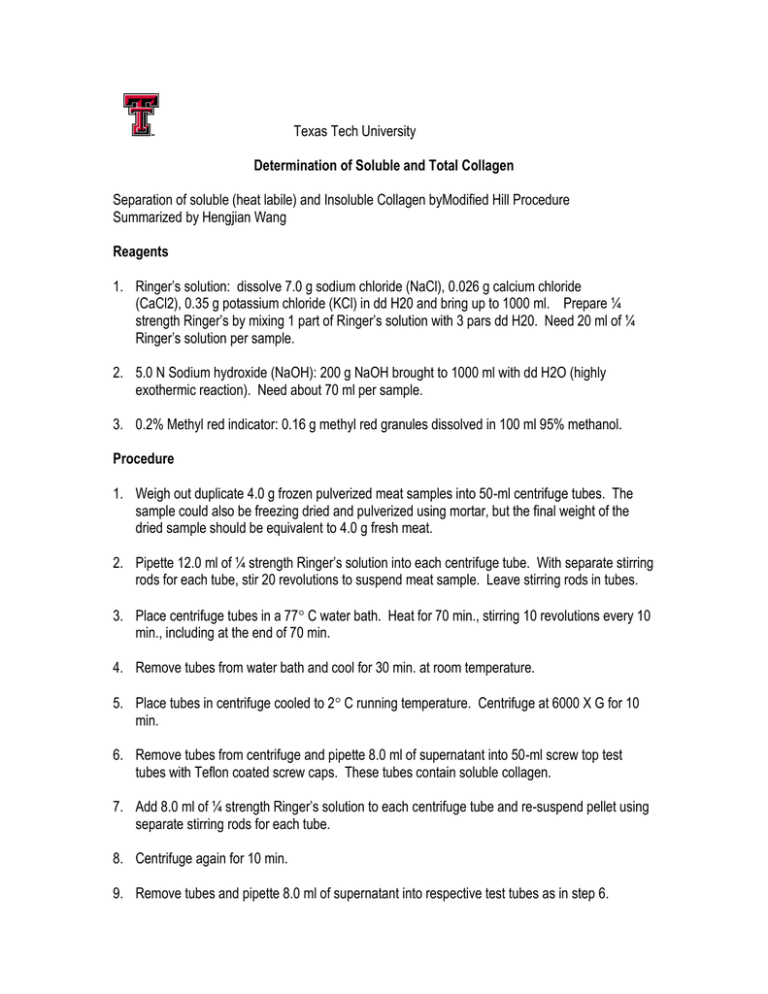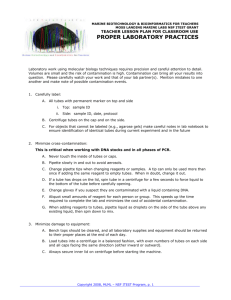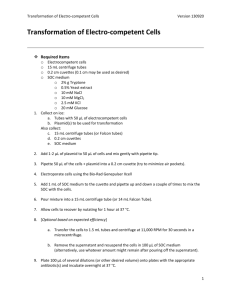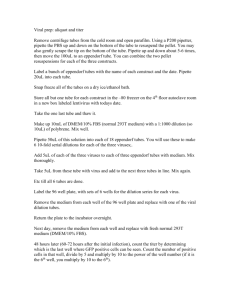Determination of Soluble and Total Collagen Texas Tech University
advertisement

Texas Tech University Determination of Soluble and Total Collagen Separation of soluble (heat labile) and Insoluble Collagen byModified Hill Procedure Summarized by Hengjian Wang Reagents 1. Ringer’s solution: dissolve 7.0 g sodium chloride (NaCl), 0.026 g calcium chloride (CaCl2), 0.35 g potassium chloride (KCl) in dd H20 and bring up to 1000 ml. Prepare ¼ strength Ringer’s by mixing 1 part of Ringer’s solution with 3 pars dd H20. Need 20 ml of ¼ Ringer’s solution per sample. 2. 5.0 N Sodium hydroxide (NaOH): 200 g NaOH brought to 1000 ml with dd H2O (highly exothermic reaction). Need about 70 ml per sample. 3. 0.2% Methyl red indicator: 0.16 g methyl red granules dissolved in 100 ml 95% methanol. Procedure 1. Weigh out duplicate 4.0 g frozen pulverized meat samples into 50-ml centrifuge tubes. The sample could also be freezing dried and pulverized using mortar, but the final weight of the dried sample should be equivalent to 4.0 g fresh meat. 2. Pipette 12.0 ml of ¼ strength Ringer’s solution into each centrifuge tube. With separate stirring rods for each tube, stir 20 revolutions to suspend meat sample. Leave stirring rods in tubes. 3. Place centrifuge tubes in a 77 C water bath. Heat for 70 min., stirring 10 revolutions every 10 min., including at the end of 70 min. 4. Remove tubes from water bath and cool for 30 min. at room temperature. 5. Place tubes in centrifuge cooled to 2 C running temperature. Centrifuge at 6000 X G for 10 min. 6. Remove tubes from centrifuge and pipette 8.0 ml of supernatant into 50-ml screw top test tubes with Teflon coated screw caps. These tubes contain soluble collagen. 7. Add 8.0 ml of ¼ strength Ringer’s solution to each centrifuge tube and re-suspend pellet using separate stirring rods for each tube. 8. Centrifuge again for 10 min. 9. Remove tubes and pipette 8.0 ml of supernatant into respective test tubes as in step 6. 10. Add 8.0 ml of dd H2O to residuals, stir to suspend (using separate stirring rods for each test tube) and pour into 50-ml screw top test tubes with Teflon coated caps. Then, under fume hood, add 10 ml of concentrated (12 N) hydrochloric acid (HCl) to centrifuge tubes to rinse and pour into respective test tubes. 11. Under fume hood, add 16 ml of concentrated HCl to each supernatant tube. 12. Screw caps on loosely and autoclave (hydrolyze) for 12 h (overnight) at 248-261 F (120-127 C) and 20 + 2 lbs of pressure. 13. Allow slow exhaust of pressure of prevent overflowing, remove tubes and cool to room temperature. 14. Add 200 mg and 900 mg carbon decolorizing agent respectively to the supernatant and residuals tubes (to clarify), mix and filter samples through Whatman No. 1 filter paper into 250 ml Erlenmeyer flasks. 15. Add 7-10 drops of methyl red indicator, mix, then slowly neutralize the sample solution with 5.0 N NAOH (15-40 ml, depending on samples) to a yellow endpoint. It is ideal to check the final pH of the solution, which should be 6.4-7.0. 16. Filter samples through Whatman No. 1 filter paper into a graduated cylinder and dilute supernatants to 100 ml and residuals to 500 ml with dd H2O (The samples could also be filtrated into the flask under vacuum and make the dilution in graduated cylinder). 17. Mix dilution well and store 10-20 ml of dilution at 4 C. Samples are now ready to analyze for hydroxyproline and are stable for 24 hrs @ 4 C. Determination of hydroxyproline by a modified Bergman and Loxley rapid procedure Reagent 1. Isopropanol, need 2.0 ml per test tube (soluble, insolude, and the standards). 2. Oxidant solution, need 1.0 ml per test tube. 3. Erlich’s reagent: need 2.0 ml per test tube. 4. 3.5 g chloramines T (4.35 for trihydrate) dissolved in 50 ml dd H2O, store in refrigerator, discard after 1 month. 5. Acetate/citrate buffer: 34.4 g sodium acetate anhydrous, 37.5 g trisodium citrate dihydrous, 5.5 g citric acid monohydrous into about 500 ml of dd water. Check if pH is close to 6.0. If not, adjust down with concentrated acetic acid, although it is best not to adjust if the pH is close to 6.0. Then add 385 ml isopropanol and bring up to 1000 ml with dd H2O. Store at room temperature and discard after 1 month. 6. Dissolve 2.0 g p-dimethylaminobenzaldehyde (DABA) into every 2.5 ml of 70% perchloric acid (mix under perchloric acid hood). The volume will be about 3.5-4.0 ml. Store in refrigerator up to one month; if green color appears, it is inactive and should not be used. 7. Stock: Dissolve 0.1 g hydroxyproline in 1000 ml of 0.001 N HCl (dilute 0.25 ml of 4 N HCl to 1000 ml) and store in refrigerator. The hydroxyproline concentration is 100 μg/ml. This solution is good for one month. 8. Working standards: 0-10 μg/ml. Pipette 0.0, 2.0, 4.0, 6.0, 8.0, and 10.0 ml of stock hydroxyprolne and brought to 100 ml volumes. Store in refrigerator (good for 1 month). Procedure 1. Pipette 1.0 ml aliquots of each sample into 15-ml screw top tubes. Also, to make a standard curve, pipette 1.0 ml of dd H2O (blank) and 1.0 ml aliquots of each standard (2.0-10.0 μg/ml). 2. Add 2.0 ml of isopropanol (1-propanol) to each tube and vortex. 3. Add 1.0 ml of oxidant solution, vortex, and allow to stand 4 min. at room temperature (17-21 C). 4. From this step, the assay should be conducted under perchloric acid hood. Add 2.0 ml Erlich’s reagent and vortex well, screw on caps to limit evaporation. 5. Heat tubes for 25 min. (15 sec) in a 60 C water bath. 6. Cool tubes for 4.5 min. in running tap water. 7. Mix and measure absorbance at 558 nm against a blank immediately (20 min. max.). 8. Collect the solution into one bottle for the special disposal. Don’t dump the waste solutions into the sink because perchloric acid is very toxic. To label the bottle, see the chemical composition on next page. Estimated composition of the Waste from Measurement of Hydroxyproline (waste disposal label in VT) Isopropanol Water, H2O P-Dimethylaminobenzaldehyde Perchloric acid Sodium acetate Sodium citrate Chloramine T Citric acid Each of NaCl, CaCl2, KCl 65.0% 28.6% 2.7% 2.4% 0.5% 0.5% 0.2% 0.07% <0.01% ____________________ Total 100% Calculations for Collagen Analysis 1. From absorbance for standards, prepare a regression of μg/ml on the X-axis and absorbance on the Y-axis. Use absorbance to obtain μg/ml of hydroxyproline for each sample. 2. Multiply μg/ml by the total volume to which the sample was diluted (100 for supernatants and 500 for residual). Divide this value by the grams of sample (4.0) to get μg hydroxyproline/g sample. 3. Convert hydroxyproline to collagen by multiplying the supernatants by 7.52 (Cross et al., 1973) and the residuals by 7.25 to μg collagen/g of sample. 4. Divide by 1000 to convert μg collagen/gram to mg gollage/gram. 5. Report as soluble collagen (supernatant), insoluble collagen (residual), total collagen (soluble + insoluble) and % soluble collagen (soluble/total x 100). References Bergman, I. and Loxley, R. 1963. Two improved and simplified methods for the spectrophotometric determination of hydroxyproline. Anal. Chem. 35:1961. Cross, H.R., Carpenter, Z. L., and Smith, G. C. 1973. Effects of intramuscular collagen and elasting on bovine muscle, tenderness. J. Food Sci. 38:998. Hill, F. 1966. The solubility of intramuscular collagen in meat animals of various ages. J. Food Sci. 31:161.






